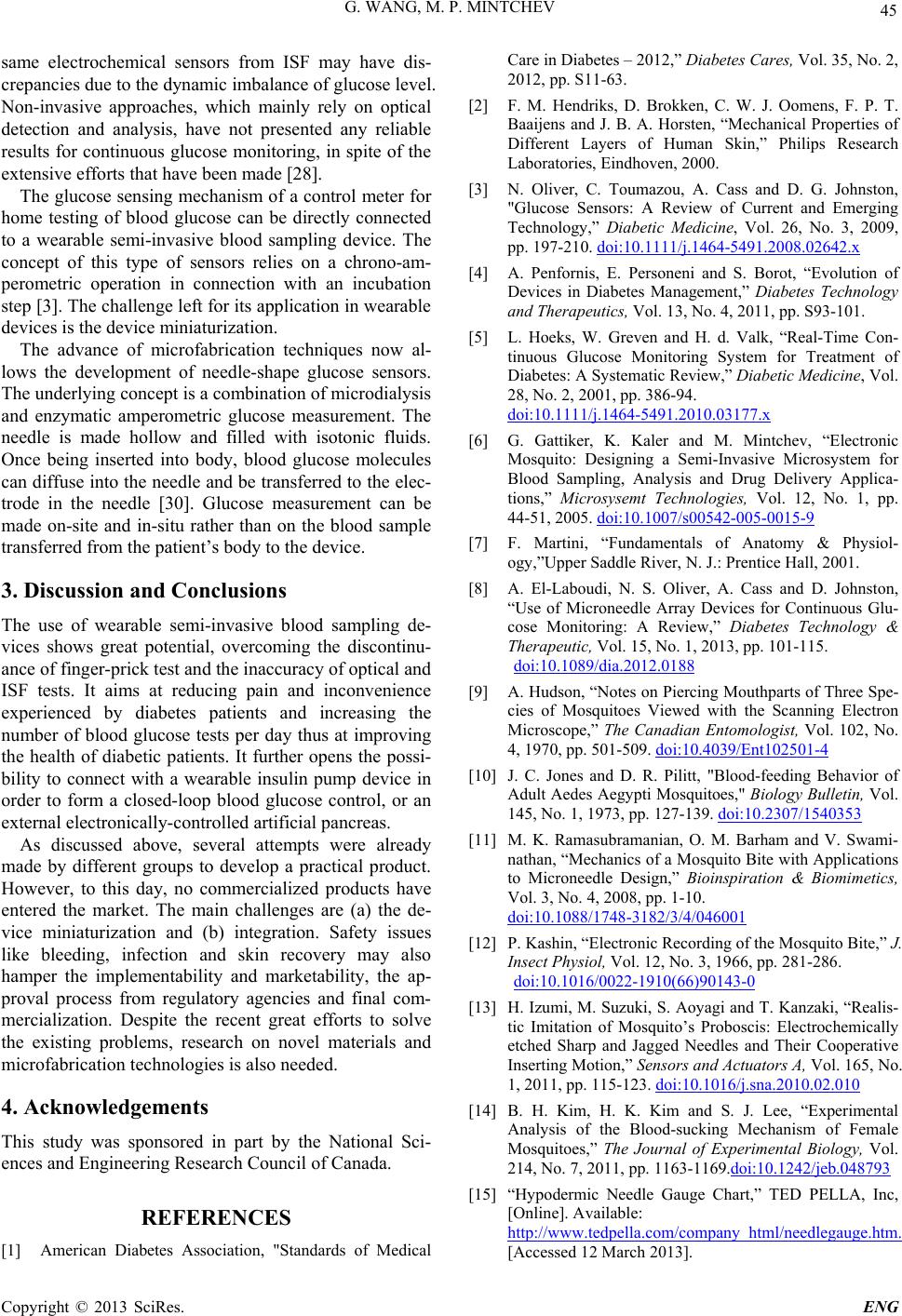
G. WANG, M. P. MINTCHEV 45
same electrochemical sensors from ISF may have dis-
crepancies due to the dynamic imbalance of glucose level.
Non-invasive approaches, which mainly rely on optical
detection and analysis, have not presented any reliable
results for continuous glucose monitoring, in spite of the
extensive efforts that have been made [28].
The glucose sensing mechanism of a control meter for
home testing of blood glucose can be directly connected
to a wearable semi-invasive blood sampling device. The
concept of this type of sensors relies on a chrono-am-
perometric operation in connection with an incubation
step [3]. The challenge left for its application in wearable
devices is the device miniaturization.
The advance of microfabrication techniques now al-
lows the development of needle-shape glucose sensors.
The underlying concept is a combination of microdialysis
and enzymatic amperometric glucose measurement. The
needle is made hollow and filled with isotonic fluids.
Once being inserted into body, blood glucose molecules
can diffuse into the needle and be transferred to the elec-
trode in the needle [30]. Glucose measurement can be
made on-site and in-situ rather than on the blood sample
transferred from the patient’s body to the device.
3. Discussion and Conclusions
The use of wearable semi-invasive blood sampling de-
vices shows great potential, overcoming the discontinu-
ance of finger-prick test and the inaccuracy of optical and
ISF tests. It aims at reducing pain and inconvenience
experienced by diabetes patients and increasing the
number of blood glucose tests per day thus at improving
the health of diabetic patients. It further opens the possi-
bility to connect with a wearable insulin pump device in
order to form a closed-loop blood glucose control, or an
external electronically-controlled artificial pancreas.
As discussed above, several attempts were already
made by different groups to develop a practical product.
However, to this day, no commercialized products have
entered the market. The main challenges are (a) the de-
vice miniaturization and (b) integration. Safety issues
like bleeding, infection and skin recovery may also
hamper the implementability and marketability, the ap-
proval process from regulatory agencies and final com-
mercialization. Despite the recent great efforts to solve
the existing problems, research on novel materials and
microfabrication technologies is also needed.
4. Acknowledgements
This study was sponsored in part by the National Sci-
ences and Engineering Research Council of Canada.
REFERENCES
[1] American Diabetes Association, "Standards of Medical
Care in Diabetes – 2012,” Diabetes Cares, Vol. 35, No. 2,
2012, pp. S11-63.
[2] F. M. Hendriks, D. Brokken, C. W. J. Oomens, F. P. T.
Baaijens and J. B. A. Horsten, “Mechanical Properties of
Different Layers of Human Skin,” Philips Research
Laboratories, Eindhoven, 2000.
[3] N. Oliver, C. Toumazou, A. Cass and D. G. Johnston,
"Glucose Sensors: A Review of Current and Emerging
Technology,” Diabetic Medicine, Vol. 26, No. 3, 2009,
pp. 197-210. doi:10.1111/j.1464-5491.2008.02642.x
[4] A. Penfornis, E. Personeni and S. Borot, “Evolution of
Devices in Diabetes Management,” Diabetes Technology
and Therapeutics, Vol. 13, No. 4, 2011, pp. S93-101.
[5] L. Hoeks, W. Greven and H. d. Valk, “Real-Time Con-
tinuous Glucose Monitoring System for Treatment of
Diabetes: A Systematic Review,” Diabetic Medicine, Vol.
28, No. 2, 2001, pp. 386-94.
doi:10.1111/j.1464-5491.2010.03177.x
[6] G. Gattiker, K. Kaler and M. Mintchev, “Electronic
Mosquito: Designing a Semi-Invasive Microsystem for
Blood Sampling, Analysis and Drug Delivery Applica-
tions,” Microsysemt Technologies, Vol. 12, No. 1, pp.
44-51, 2005. doi:10.1007/s00542-005-0015-9
[7] F. Martini, “Fundamentals of Anatomy & Physiol-
ogy,”Upper Saddle River, N. J.: Prentice Hall, 2001.
[8] A. El-Laboudi, N. S. Oliver, A. Cass and D. Johnston,
“Use of Microneedle Array Devices for Continuous Glu-
cose Monitoring: A Review,” Diabetes Technology &
Therapeutic, Vol. 15, No. 1, 2013, pp. 101-115.
doi:10.1089/dia.2012.0188
[9] A. Hudson, “Notes on Piercing Mouthparts of Three Spe-
cies of Mosquitoes Viewed with the Scanning Electron
Microscope,” The Canadian Entomologist, Vol. 102, No.
4, 1970, pp. 501-509. doi:10.4039/Ent102501-4
[10] J. C. Jones and D. R. Pilitt, "Blood-feeding Behavior of
Adult Aedes Aegypti Mosquitoes," Biology Bulletin, Vol.
145, No. 1, 1973, pp. 127-139. doi:10.2307/1540353
[11] M. K. Ramasubramanian, O. M. Barham and V. Swami-
nathan, “Mechanics of a Mosquito Bite with Applications
to Microneedle Design,” Bioinspiration & Biomimetics,
Vol. 3, No. 4, 2008, pp. 1-10.
doi:10.1088/1748-3182/3/4/046001
[12] P. Kashin, “Electronic Recording of the Mosquito Bite,” J.
Insect Physiol, Vol. 12, No. 3, 1966, pp. 281-286.
doi:10.1016/0022-1910(66)90143-0
[13] H. Izumi, M. Suzuki, S. Aoyagi and T. Kanzaki, “Realis-
tic Imitation of Mosquito’s Proboscis: Electrochemically
etched Sharp and Jagged Needles and Their Cooperative
Inserting Motion,” Sensors and Actuators A, Vol. 165, No.
1, 2011, pp. 115-123. doi:10.1016/j.sna.2010.02.010
[14] B. H. Kim, H. K. Kim and S. J. Lee, “Experimental
Analysis of the Blood-sucking Mechanism of Female
Mosquitoes,” The Journal of Experimental Biology, Vol.
214, No. 7, 2011, pp. 1163-1169.doi:10.1242/jeb.048793
[15] “Hypodermic Needle Gauge Chart,” TED PELLA, Inc,
[Online]. Available:
http://www.tedpella.com/company_html/needlegauge.htm.
[Accessed 12 March 2013].
Copyright © 2013 SciRes. ENG